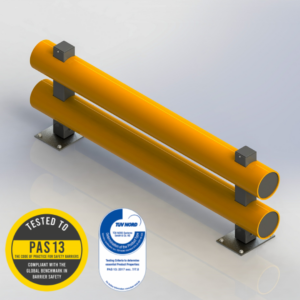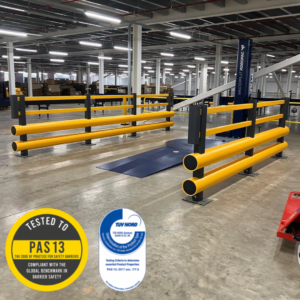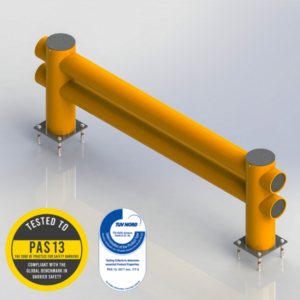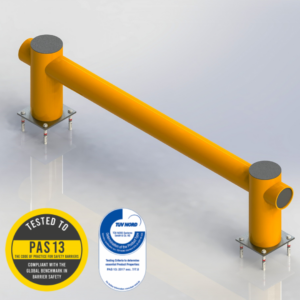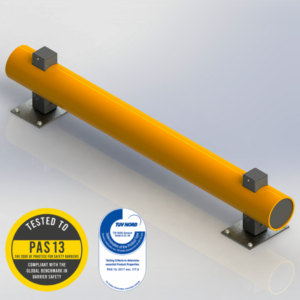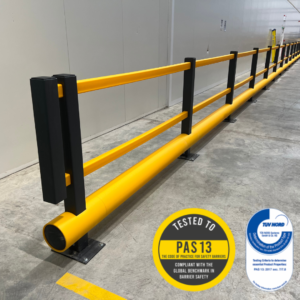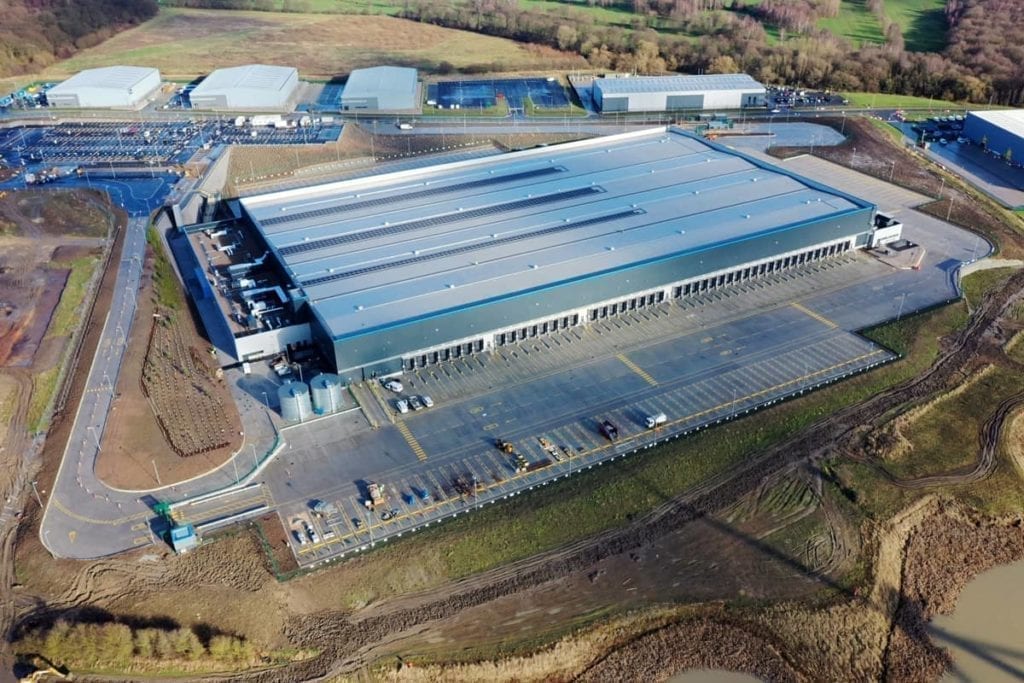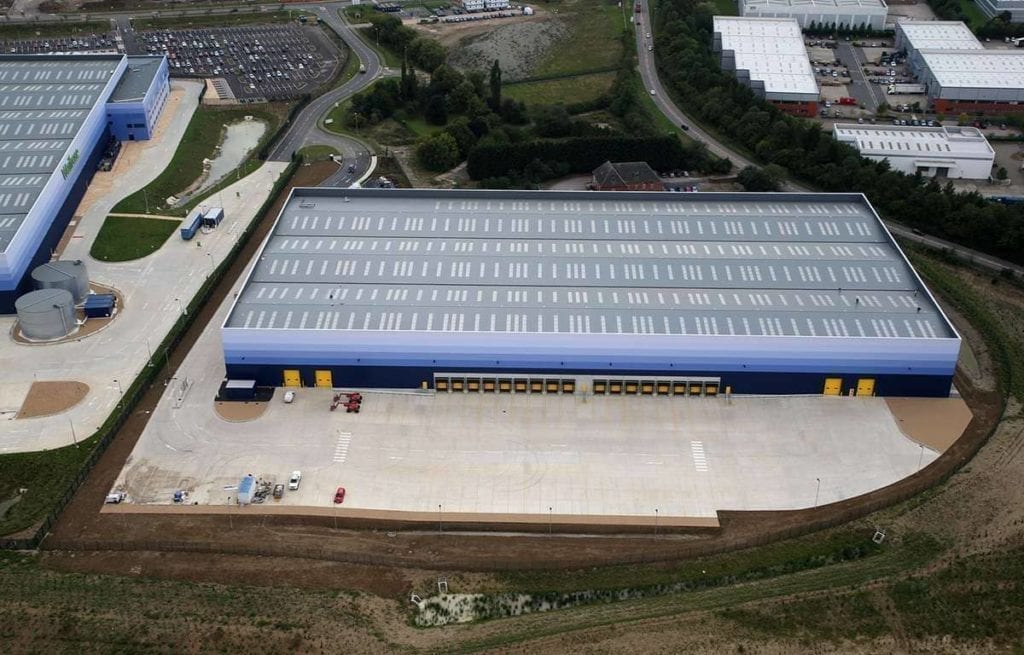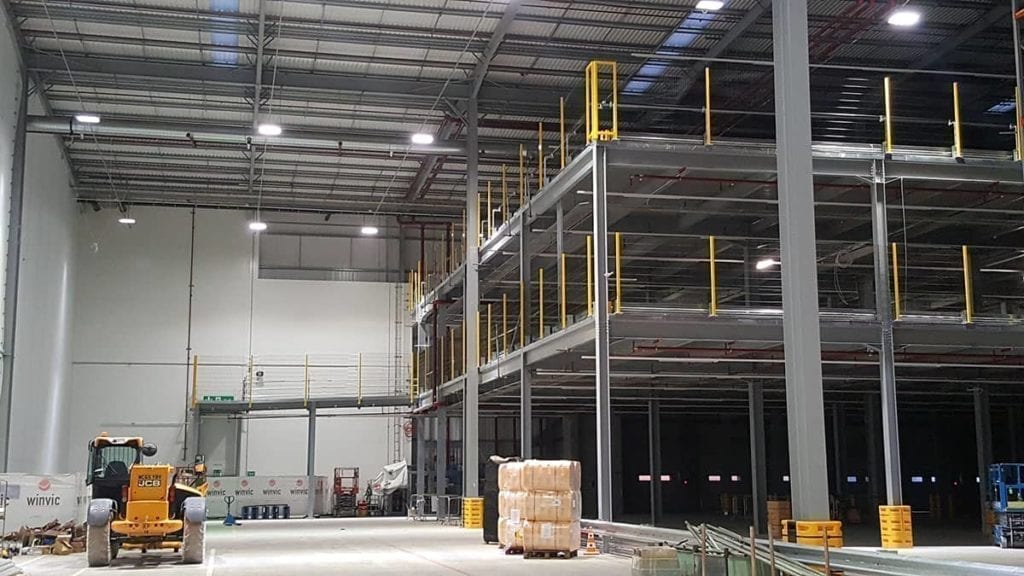Applications of our Polymer Safety barriers – PAS 13 Tested include:
Warehouses
Deploy the Double Bumper Pedestrian Safety Barrier to create secure pedestrian walkways throughout warehouses. End of Aisle Double Rail Barriers are used to secure racking along the main forklift traffic routes. This facilitates the smooth movement of personnel while preventing accidents in workspaces shared with forklifts and other equipment. The Pedestrian Safety Barriers (SEG+) are particularly suited for segregating forklifts and pedestrians in areas with a significant volume of foot traffic, such as production lines, assembly areas, and busy logistic centre environments.
Food Production Facilities
Implement our Pedestrian Safety Barriers in food processing zones to maintain a distinct separation between workers and equipment. This ensures hygienic operations and reduces the risk of collisions. Our Polymer range from Single Bumper Barriers to Double Bumper Pedestrian Barriers are excellent for areas where water, mould, corrosion, and solvents will unavoidably be prevalent.
Industrial Facilities
Enhance safety by using the Polymer Safety Barrier to establish dedicated pedestrian pathways. End of Aisle Single Rail Barriers are used to secure racking along the main forklift traffic routes. This segregation of foot traffic from machinery and vehicles prevents potential accidents in bustling industrial environments. Our Pedestrian Safety Barriers (SEG+) and Double Bumper Pedestrian Barriers are perfect for separating forklifts and equipment from pedestrian routes, protecting low impacts along the ground.
Freezer Environments
The durable construction of the Polymer Safety Barrier, combined with its ability to withstand extreme temperatures, renders it suitable for use in freezer storage areas. It provides clear demarcation and safety for personnel navigating in sub-zero conditions. Our Polymer range from Double Bumper Barriers to Single Bumper Pedestrian Barriers are excellent for areas where water, mould, corrosion, and solvents will unavoidably be prevalent.
Learn more about TÜV NORD and PAS 13 testing.
PAS 13 Testing Standard: The PAS 13 (Publicly Available Specification) is a British standard for evaluating the impact resistance of vehicle security barriers. It involves rigorous testing to assess how well a barrier can withstand a vehicle impact without compromising safety. For polymer safety barriers, PAS 13 testing ensures they meet stringent safety criteria, making them suitable for various applications such as loading bays, logistic centres, and food production cold storage areas.
TUV Nord is a technical service provider that offers certification, testing, and inspection of various products and systems. It is important for polymer safety barriers to be independently tested by TUV Nord or other accredited laboratories to ensure that they meet the required standards of safety, quality, and performance. Independent testing also provides scientific evidence of the impact resistance and durability of polymer safety barriers, which can help customers make informed decisions and avoid costly damages or injuries.
Additionally, once the testing is completed by a third party it is important to know that the production cannot change. The materials, process, and design must stay the same as of the time of testing or they will need to be verified by the independent third party to stay accredited. Many businesses with non-tested and accredited barriers can therefore change their entire process from one product to another. With PAS 13 and independent third-party testing this process is guaranteed to be the same. Therefore, our product quality is guaranteed with this independent testing.
Benefits of PAS 13 Tested Barriers: PAS 13 Tested Barriers offer several advantages over non-PAS 13 tested barriers:
- Enhanced Safety: PAS 13 testing ensures that the barriers meet specific safety standards, reducing the risk of vehicle penetration and increasing protection for pedestrians and property.
- Reliability: PAS 13 testing guarantees consistent performance, giving you confidence that the barrier will perform as intended in real-world scenarios.
- Compliance: Many industries and regulations require PAS 13 compliance for safety barriers, so using PAS 13 Tested Barriers ensures you meet these standards.
- Cost-Efficiency: While they may have a slightly higher upfront cost, PAS 13 Tested Barriers can save money in the long run by reducing repair and replacement expenses resulting from vehicle impacts.
Choosing PAS 13 Tested Polymer Safety Barriers is a proactive step towards ensuring the safety of your premises, assets, and personnel, backed by rigorous testing and proven durability.
Durability and Impact Resistance: Our polymer safety barriers are engineered to be exceptionally durable and offer high impact resistance. They are designed to absorb and dissipate the force of a vehicle impact, preventing damage to the barrier itself and, more importantly, protecting the surrounding infrastructure and people. These barriers are built to withstand repeated impacts while maintaining their structural integrity.
Each Data Sheet has the individual products maximum impact energy for direct collisions.
Polymer barriers are commonly used in loading bays, warehouses, distribution centres, manufacturing facilities, and parking areas, wherever impact protection is required.
They are designed to protect people, assets, and infrastructure from industrial vehicle impacts. They can also withstand harsh environments, such as sub-zero temperatures, and return to their original shape after collisions.
Some industries that find the most use for polymer barriers are:
- Manufacturing: Polymer barriers can segregate and guide heavy vehicles, such as forklifts, and prevent damage to structures, equipment, and personnel.
- Warehousing and distribution: Polymer barriers can protect racking and storage systems from impacts, as well as define safe walkways and loading zones for workers.
- Airports: Polymer barriers can withstand repeat impacts from large and heavy airport vehicles, such as tugs and baggage carts, and safeguard critical assets, such as floodlight towers, masts, and columns.
- Car parks: Polymer barriers can protect ramps, walls, and walkways from damage by cars, vans, and motorbikes, and also prevent unauthorized access with anti-climb mesh.
- Food and Beverage: Polymer barriers can protect machinery, walkways, and critical infrastructure from corrosion, contamination, and impact damage caused by food processing and handling operations, such as high and low temperatures, acidic or alkaline solutions, and abrasive or sticky substances. Polymer barriers can also improve hygiene, safety, and efficiency in food and beverage facilities by reducing maintenance, cleaning, and repair costs.
Polymer barriers are plastic barriers that have many advantages over metal barriers in industrial settings. Some of the advantages are:
- They are more flexible and can absorb and disperse impact forces better than metal barriers, which can dent, scratch, or damage the floor and vehicles.
- They are more durable and can withstand harsh environments, such as high temperatures, corrosive substances, and abrasive materials.
- They are more cost-effective and require less maintenance, repair, and replacement than metal barriers.
- They are more eco-friendly and can be recycled and reprocessed, reducing carbon emissions and energy consumption.
Polymer barriers can offer several benefits to your business:
- Cost-effective and long-term industrial protection: Polymer barriers are made up of millions of smaller molecules, allowing them to take an impact and reform to their original shape. This makes them more cost-effective and provides longer-term industrial protection than standard steel or concrete safety barriers.
- Increased staff awareness: The presence of safety barriers can help maintain staff awareness of their surroundings, potentially reducing the risk of accidents.
- Vehicular protection: Safety barriers can reduce potential damage to your vehicular fleet. In the event of a collision, a safety barrier can dramatically lower the risk of physical injury and expansive damage to the vehicle.
- Policy compliance: Safety barriers can be an important part of your company’s Health and Safety Policy, helping to ensure that all workers are knowledgeable and clued-up on the protocols in place.
Knowing when to replace a polymer barrier depends on several factors:
- Physical Damage: If the barrier shows signs of significant physical damage, such as deep scratches, cracks, or deformations, it may need to be replaced.
- Performance: If the barrier is no longer effectively absorbing impacts or has lost its shape, it may be time for a replacement.
- Age: Over time, exposure to harsh environmental conditions can degrade the barrier. If the barrier is old and showing signs of wear and tear, consider replacing it.
- Changes in Safety Standards: If there have been updates to safety standards or regulations that your current barriers do not meet, you may need to replace them.
Remember, regular inspections and maintenance are key to ensuring the longevity and effectiveness of your polymer barriers. Always consult with a professional or the manufacturer for the best practices.

